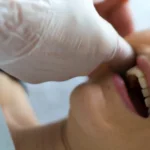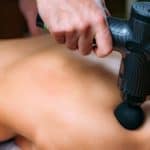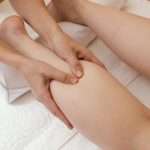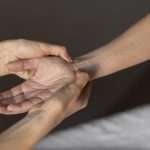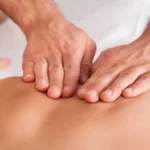Gas in the stomach can cause bloating, discomfort, and cramping, leading to an uncomfortable feeling. Fortunately, it is possible to relieve gas and its associated symptoms with a simple massage. In this article, we will discuss how to massage gas out of the stomach quickly and easily. We will provide step-by-step instructions on how to perform the massage, as well as discuss potential benefits and cautions. By the end of this article, you will have a greater understanding of how to massage gas out of your stomach in order to reduce bloating and discomfort.
What is Gas in the Stomach?

Gas in the stomach is the air or gas that is present in the stomach or intestines. It is caused by swallowing air, eating or drinking too quickly, eating food that is difficult to digest, or a combination of these factors. Gas can also be caused by bacteria in the digestive tract breaking down undigested food. When gas accumulates in the stomach, it can cause bloating, discomfort, and pain.
How to Get Rid of Bloating Massage:
Massaging the stomach can help to reduce the amount of gas in the stomach and provide relief from bloating and discomfort. Massaging can help to move gas through the intestines and reduce the pressure that gas can cause in the stomach. It can also help reduce cramping and pain associated with gas. Massage can be done with a variety of techniques, including kneading, rubbing, and tapping.
How to Massage Gas Out of Stomach

Massage Techniques
1. Place your hands on your belly and make small circles, moving in a clockwise direction. This massage is known as the abdominal massage and it helps to move gas and other toxins out of your stomach and intestine.
2. Use your fingertips to massage your abdominal area in a clockwise direction. This helps to move gas and other toxins out of your stomach.
3. Massage your stomach in a downward direction. This helps to move gas and other toxins out of your stomach and intestine.
Other Techniques to Help Relieve Bloating and Discomfort
1. Drink plenty of water and other fluids to help keep your digestive system functioning properly.
2. Eat smaller meals throughout the day instead of large meals. This helps to reduce the amount of gas in your stomach.
3. Exercise regularly to help keep your digestive system functioning properly.
4. Try taking a warm bath or using a heating pad to relax your stomach muscles and help reduce bloating.
Using massage and other techniques can be an effective way to get rid of gas in your stomach and relieve bloating and discomfort. Massaging your stomach in a clockwise direction can help to move gas and other toxins out of your stomach and intestine. Additionally, drinking plenty of fluids, eating smaller meals, exercising regularly, and taking warm baths can all help to reduce bloating and discomfort.
How to Massage the Digestive System

- Gently massage the abdomen in a clockwise direction using firm, yet gentle pressure.
- Apply pressure to the lower abdomen to promote digestion.
- Massage the area around the navel in a circular motion to boost digestion.
- Press along the entire length of the large intestine for relief from stomach ache.
- Place your hands flat on the lower abdomen and move them in a clockwise direction.
Massaging the digestive system helps to stimulate digestion, reduce bloating, and relieve cramps. It also helps to improve circulation and relax the muscles. This can be done with or without oil. To massage the digestive system, start by lying on your back or sitting in a comfortable position. Gently massage the abdomen in a clockwise direction using firm, yet gentle pressure. Apply pressure to the lower abdomen to promote digestion. Massage the area around the navel in a circular motion to boost digestion. Press along the entire length of the large intestine for relief from stomach ache. Place your hands flat on the lower abdomen and move them in a clockwise direction. Make sure to be gentle and use only light pressure.
Safety Considerations

Before performing a massage to relieve gas, it is important to take certain safety considerations into account.
| Safety Considerations | Action |
|---|---|
| Avoid excessive pressure | Perform the massage with light to moderate pressure to avoid causing any further discomfort. |
| Move in a circular motion | Apply a gentle circular motion when performing the massage, rather than pressing down in one spot for an extended period of time. |
| Avoid massaging too hard | Be careful not to massage too hard, as this can cause more discomfort or even pain. |
| Stop if it hurts | Stop the massage immediately if it causes any pain or discomfort. |
| Avoid massaging over bruises | Avoid massaging over any bruises or other injuries. |
In addition, it is important to be aware of any underlying medical conditions that may be affected by performing a massage to relieve gas. Consult with a healthcare professional before attempting to relieve gas through massage.
What Does Stomach Massage Do?
Stomach massage is a popular and simple way to help relieve bloating and discomfort from gas. Massaging the stomach helps to stimulate digestive activity and move trapped gas through the system. It can also help reduce stress, improve circulation, and increase relaxation.
Stomach massage can help:
| Benefit | Description |
|---|---|
| Relieve bloating | Stimulate digestive activity and move trapped gas through the system |
| Reduce stress | Help relax the muscles in the abdomen, reducing tension and stress |
| Improve circulation | Massage helps increase circulation to the abdominal area |
| Increase relaxation | Helps to soothe and relax the muscles in the abdomen |
Stomach massage is a great way to help relieve gas and bloating, as well as reduce stress and improve circulation. It is an easy and quick way to help ease discomfort and promote better digestion. With regular massage, it can also help to prevent future episodes of gas and bloating.
Frequently Asked Questions
What are the Benefits of Massaging the Stomach to Relieve Bloating and Discomfort?
1. Improves Digestion: Massaging the abdomen helps to stimulate the digestive system, aiding in the breakdown of food and the absorption of nutrients. This helps to relieve any digestive issues, such as bloating and constipation.
2. Boosts Circulation: Massaging the stomach helps to increase the circulation of blood and oxygen to the area. This can help to reduce any discomfort caused by gas and bloating.
3. Reduces Stress: Massaging the abdomen can help to reduce stress and anxiety, which can lead to tension in the stomach and digestive system. This can help to reduce bloating and discomfort.
4. Reduces Bloating: Massaging the stomach can help to alleviate bloating and discomfort by helping to break down the gas in the abdominal area. This can help to reduce any pain and discomfort associated with bloating.
5. Promotes Relaxation: Massaging the stomach can help to promote relaxation and reduce stress, which can help to reduce any gas and bloating in the abdominal area. This can help to make the body feel more comfortable and relaxed.
What are the Risks Associated with Massaging the Stomach to Relieve Bloating and Discomfort?
Massaging the stomach to relieve bloating and discomfort can carry risks, such as:
- Vomiting: Massaging the stomach can stimulate digestive acids, leading to vomiting.
- Stomach Injury: Abdominal massage can cause discomfort or pain in those with existing stomach ailments.
- Infection: Poor hygiene while performing abdominal massage can lead to infection.
It is recommended to consult with a doctor before attempting abdominal massage to ensure a safe and effective experience.
Is Massage Therapy Effective for Relieving Bloating and Discomfort?
Yes, massage therapy can be effective in relieving bloating and discomfort. Massage works by stimulating the nerves in the stomach, which can help relax the abdominal muscles, reduce bloating, and improve digestion. It can also increase blood flow to the area, which can help reduce inflammation and pain. Additionally, massage can help reduce stress, which can contribute to an upset stomach.
Are there any techniques or tools to help with the massage?
Using massage tools such as tennis or lacrosse balls, foam rollers, or massage sticks can help to apply pressure to the abdomen and break up gas bubbles. Massagers with adjustable settings or variable speeds can also be used to vary the intensity of the massage. Additionally, using massage oil or lotion can help to reduce friction and make the massage more comfortable.
How Often Should Someone Massage Their Stomach To Relieve Bloating And Discomfort?
Massaging your stomach on a regular basis can help reduce bloating and relieve discomfort. It is recommended to massage your stomach at least once a day, or more often if you are experiencing severe bloating. Additionally, you can massage your stomach before or after meals to help with digestion and reduce gas.
Final Thoughts
Massaging the stomach is an effective and painless way to relieve bloating and discomfort associated with gas buildup. It is quick, easy and can be done in the comfort of one’s own home. Massaging the stomach can be combined with other natural remedies, such as diet changes and yoga poses, to help ease and prevent stomach issues.
References
- WebMD: Bloating: Causes and Relief
- Mayo Clinic: Gas and Gas Pains: Symptoms and Causes
- Wikipedia: Gas Pain




